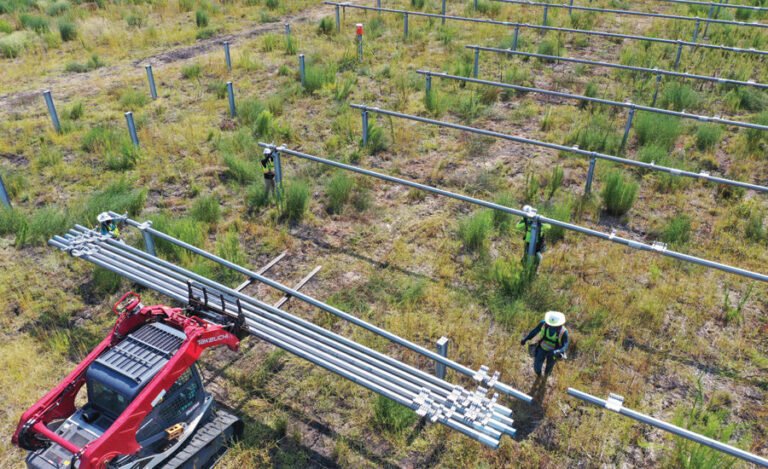A small whispering sound reverberates across 1,100 acres of flat land about 40 miles south of Houston. It stops after a few seconds followed by a quick beep and then restarts.
The sounds come from CIVDOT, an autonomous ground vehicle developed by San Francisco-based technology firm Civ Robotics to mark where the stacks will be moved for Cutlass Solar II, a 218 MW solar power project being built by a team led by Bechtel in Fort Bend. County, Texas, for a US unit of Turkish developer Sabanci Renewables.
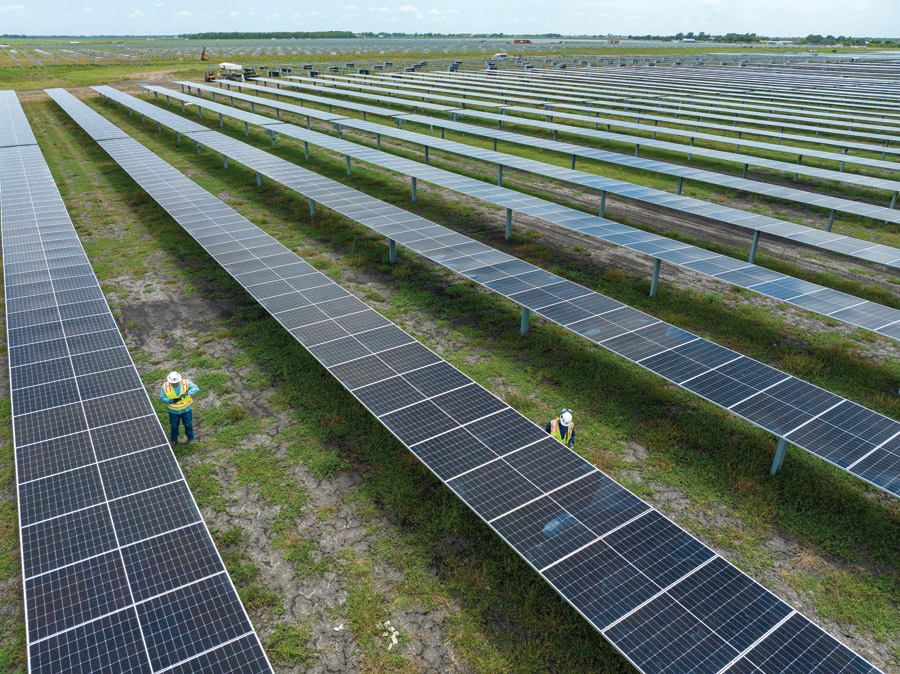
More than 500,000 bifacial solar panels are being installed for the Cutlass Solar II project.
Photo courtesy of Bechtel
With about 500,000 bifacial solar panels that absorb energy on two sides, Cutlass Solar II will produce enough renewable energy to power 40,000 homes when it’s completed this spring and save about 600,000 metric tons of carbon dioxide from entering the atmosphere each year. says the developer.
The energy generated by the project will be transmitted to ERCOT, the company that manages 90% of the state’s energy network. The companies did not disclose the cost of the project. Bechtel Enterprises, the contractor’s development and project financing arm, said last year that it “was instrumental in the development” of Cutlass Solar II.
CIVDOT wheels around 4 inches. rubber tires, stopping every few meters to release a dot of orange paint that marks where a pile will go. 5 feet away is field engineer Jorge Careaga, head down, fingers dancing across the screen of a tablet ensuring CIVDOT stays on course and directly follows the pile assembly plan.
The pile controller for the more than 90,000 piles includes a touch screen and a joystick that allows an operator to hammer them deep into the ground. From an open-air seat, the operator delicately wields the joystick guiding a steel pile while keeping a close eye on the touchscreen to make sure it’s driving straight. If the stack deviates, the display instantly informs the operator to reverse course.
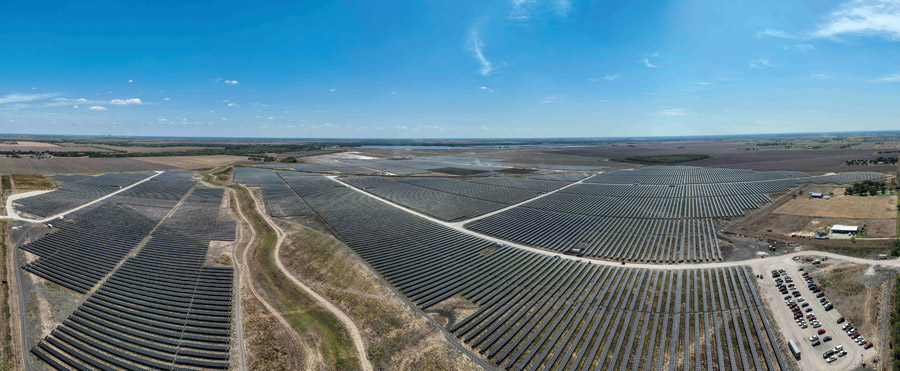
A single-lane dirt road separates Cutlass Solar II from the Cutlass Solar I project in rural Texas that was completed earlier.
Photo courtesy of Bechtel
With so many piles to drive, technology is key to saving hundreds of hours of work, according to project team members. CIVDOT improved survey time by six times; and the pile driver’s instant quality feedback has sped this task three to five times compared to traditional methods, Bechtel officials note.
“Drone footage from daily flights is uploaded across the team for faster, safer and ultimately smarter decision making.
—Wyatt Ferguson, equipment specialist, Bechtel
Frank McAlpin, Bechtel’s project manager for Cutlass Solar II, says a wide variety of technology is being used to accelerate the project’s schedule and quality. The company is responsible for managing the design, engineering, procurement, construction and commissioning of the project. The 100% digital delivery of the project includes data-driven automation, survey robots, machine-controlled equipment and drones.
Bechtel equipment specialist Wyatt Ferguson noted the use of drones from the initial design phase through customer handover for reporting, inspections, quality foundations and site clearance. “Images from daily flights are uploaded to the entire project team for faster, safer and ultimately smarter decision-making,” he says.
Bechtel’s custom software pulls together elements of the project’s work process to create a “complete interactive map-based visualization,” making data-driven decisions easier and faster, says Jeremy Blackwell, project cost control manager .
“The Cutlass Solar II project provides not only a glimpse of how this team is leading innovation in the engineering and construction industry, but also a prediction of how construction projects could be built more efficiently in the future.” he says

When Cutlass Solar II is completed this spring, it will be able to power 40,000 homes.
Photo courtesy of Bechtel
Scope and workforce
“Developing utility-scale solar power installations is one of the most efficient ways to reduce emissions and put the world on the path to clean energy.”
—Kelley Brown, vice president of renewable energy, Bechtel
Across a single-lane dirt road from Cutlass Solar II is the Bechtel-built Cutlass Solar I project, where much of the technology was launched. The 345,000-panel site began operations in January 2023 and generates 140 MW on 700 acres.
But Cutlass Solar II, considered industrial-scale, poses a greater challenge given its size and schedule, according to site manager Taylor Carlson. The project has a 10-month construction schedule and a two-month commissioning and commissioning period, he says. “Every minute counts,” Carlson says, though he’s confident the team “will be successful” in meeting the goals.
At its peak, there were more than 300 people on site, McAlpin says, with off-site support team members in Texas, Virginia and India.
Amidst the sea of deep blue solar panels, workers in reflective vests and white helmets raise their heads or raise their hands to visitors. A notable number are women. Bechtel officials say about 15 percent of the project’s craftsmen are women, compared to an industry standard of 6 percent. McAlpin says 30 percent of Cutlass Solar I workers are also building the second renewable energy project. In February, the team is scheduled to finish installing the final Cutlass Solar II solar panels.
Crediting the entire project development team, McAlpin says he is “proud and inspired by how [the team] has worked as a cohesive unit to exceed our project plan.”
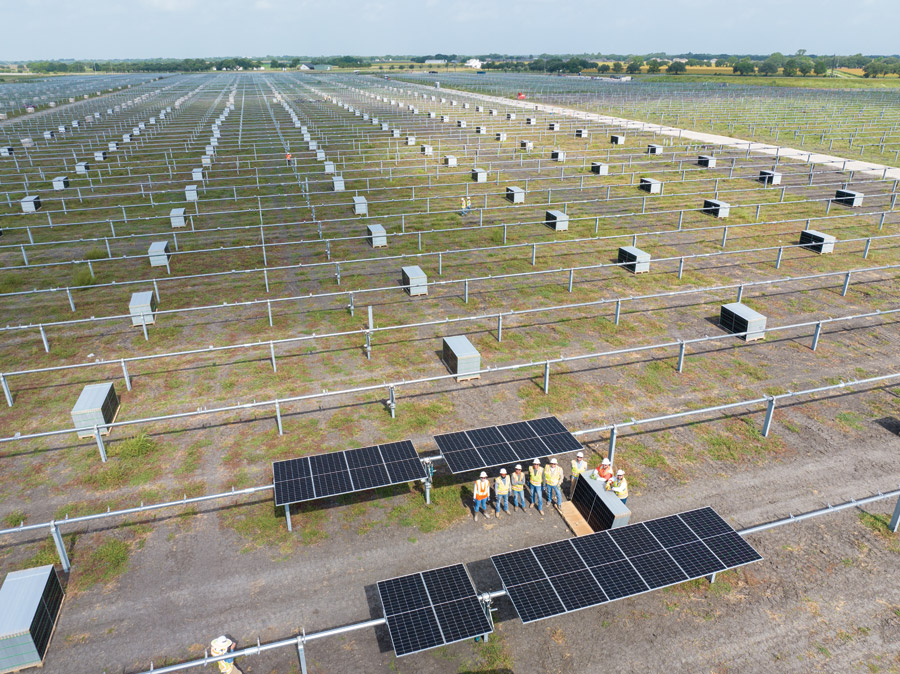
Texas power grid ERCOT will buy power from the 272 MW project.
Photo courtesy of Bechtel
Increase in renewables
Bechtel and owner Sabanci have forged a successful partnership in renewables development, company officials say. Also scheduled for completion in 2025 is the 232 MW Oriana solar project in Victoria County, Texas.
Renewable energy growth and demand have increased significantly over the past decade, says Kelley Brown, Bechtel EPC’s chief operating officer and senior vice president of US renewable energy, in an interview with ENR. After California, Texas is the second-largest producer of solar power in the US and is slated to install more than 4 GW of capacity over the next five years to become the national leader, he says.
Sabanci Holdings, the developer’s parent, plans to expand its US renewable energy investment to about 1 GW by 2025, including solar, onshore wind and utility-scale battery storage in Texas, as well as in two transmission markets regional
To achieve that goal, developers and decision-makers need to look not only at the number of solar projects, but also at their scale, Brown says. A key factor in the company’s focus on technology is ensuring that projects are delivered quickly and with high quality. He describes Texas as a “hotbed” of renewable energy, seeing “diverse prospects” in the Gulf Coast region.
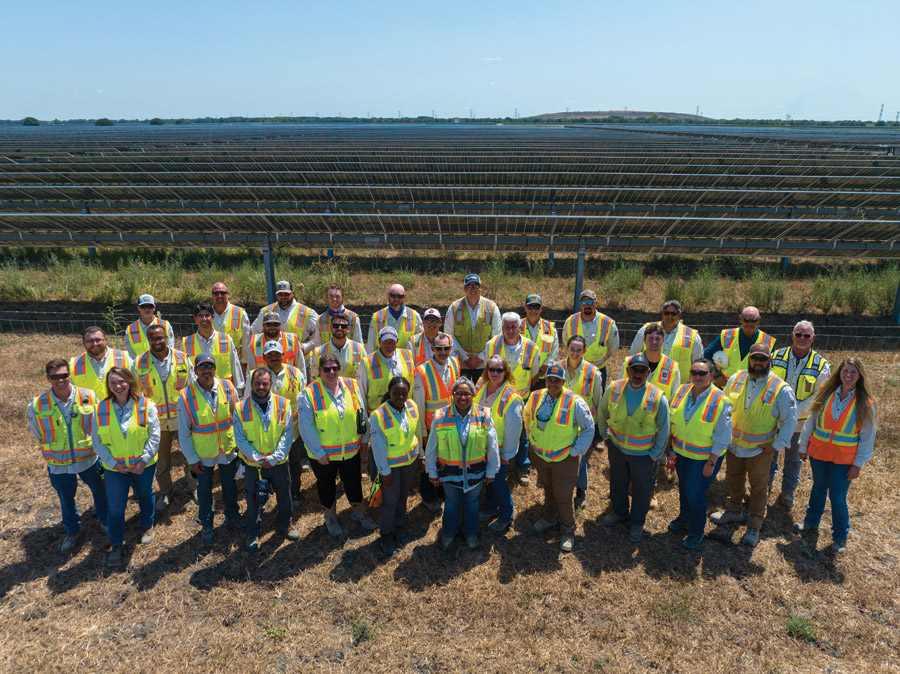
About 300 people worked on the solar project at peak, with women making up 15% of the craft ranks.
Photo courtesy of Bechtel
Brown says Reston, Va.-based Bechtel has spent more than 125 years helping customers navigate changes in energy use, technology change and financing challenges, and now continues to develop a more thoughtful approach in sustainable alternatives. The company considers it valid to support carbon-free energy production to support the global energy transition and energy demand, including wind, solar, hydroelectric, nuclear and battery storage. Bechtel also has an active interest in renewables in Australia and the UK, he says.
Known for its engineering and construction megaprojects, Bechtel is helping clients decarbonize their energy portfolios and adapt to the use of renewable energy, he says. “Developing utility-scale solar power installations is one of the most efficient ways to reduce emissions and put the world on the path to a clean energy future.”

